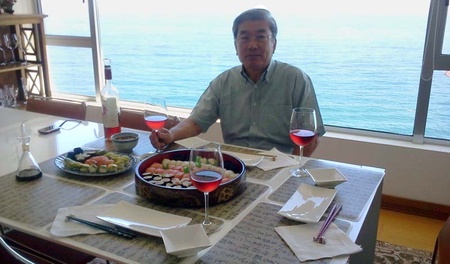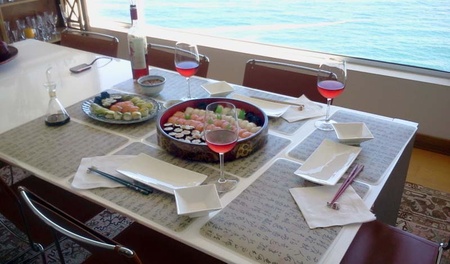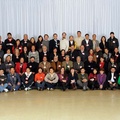Yo soy un nikkei (nisei) nacido en Chile y criado en la zona central. Mis abuelos maternos y mi madre, llegados al país en 1929, añoraron siempre las comidas japonesas, lo mismo que mi padre que llegó en 1936.
Recuerdo que pescados para sashimi siempre encontraban, pero, no había wasabi ni shoyu. El primero no se consideraba o se reemplazaba por rábano rallado (daikon oroshi) y el shoyu era reemplazado por un sucedáneo a base de carne de vacuno. En todo caso, también había arroz, por lo que el gohan nunca faltaba. Es por eso que para los nisei, el sashimi tiene que ir acompañado con gohan.
Dentro del equipaje de los emigrantes que llegaron antes de la II Guerra, siempre venían algunos elementos que ellos suponían que no iban a encontrar en Chile. Por ejempo, el suribachi que permitía hacer kamaboko con pescados locales y una especie de cajitas de Madera, parecidas a las mandolinas actuales para raspar katsuobushi que venía en unas duras barras como de madera, casi petrificadas por el tiempo. También trajeron semillas y plantas que en esos tiempos no era necesario declarar; mi abuelo, recuerdo, cultivó entre otras cosas, hechima, konnyaku, shungiku. Por lo tanto, tuvimos la oportunidad de comer tempura de shungiku y cuando no había, mi madre los hacía con hojas tiernas de crisantemo.
Otro aspecto interesante es que la comida estuvo mezclada con algunas costumbres japonesas de siempre. En Santiago, en la Sociedad Japonesa todos los años, a fines de diciembre, se realiza un “mochitsuki” en preparación al año nuevo. Así, a temprana edad, conocimos el mochi y sus distintas maneras de consumirlo, primero fresco con kinako, luego en Zooni y por último asado untado en shoyu con azúcar.

Niguiri zushi casero acompañado con vino rosé (Foto del album familiar de los Hirose: http://www.discovernikkei.org/nikkeialbum/albums/518/)
En mi niñez mi padre trabajaba en una empresa minera japonesa en el norte de Chile y cada cierto tiempo llegaba al puerto minero un barco japonés y en más de una oportunidad fuimos invitados a almorzar o cenar con el Capitán. Allí conocimos la bebida gaseosa saida, los osenbe y caramelos Lotte. También nuestro padre conseguía natto que mucho le gustaba ya que era oriundo de Fukushima, aunque nacido en Ishinomaki. Esa es una de las razones por la que a mi me gusta mucho el natto, a tal punto que cuando aun no se podía conseguir en Chile, por los años 1980, tenía un amigo que me enviaba el fermento natto kin desde Japón y yo me fabriqué una caja térmica que mantenía la temperatura a unos 40º C y hacía natto fresco con porotos soya. Ya desde hace unos 20 años atrás se comenzó a importar natto desde California.
Una cosa curiosa que sucedió en casa fue que tres sobrinos no Nikkei, por parte de mi señora, vivieron en casa mientras estudiaban en la universidad. Los tres son locos por el natto, siendo totalmente chilenos. Creo que ellos han adquirido bastante de la cultura culinaria nikkei al vivir por unos años en casa.
A mi me gusta la cocina, pero mayormente el sashimi y sushi que hacemos en casa. Y los aprendimos a hacer desde jóvenes, porque en Chile no había restaurantes japoneses. Desde hace un par de décadas, se instalaron muchos de ellos, al principio con Itamae japoneses y luego se expandió con cocineros chilenos. Las adaptaciones han sido múltiples y en los rolls no falta el queso philadelphia y la palta o abocado, Rolls de témpura o de espárragos.
Los que vivimos nuestra niñez, entre los 1940 y 1960, disfrutamos mucho de los sukiyaki familiares. Nos gustaba mucho porque era todo un evento reunirse frente a un anafe o cocinilla con una paila encima y lo más impresionante era que el papá intervenía en la preparación y nos iba dando indicaciones de cómo quedaba más delicioso. Con el huevo crudo como salsa se coronaba la delicia. Por supuesto, tampoco podía faltar el gohan. La adaptación de los ingredientes era otro tema; no había hakusai pero sí repollo y espinaca; no había tofu ni negi, pero había cebollas.
A mi familia, también le gusta los nabe ryoori en donde combinamos en el caldo de pollo, carne de pollo, pescados y mariscos, que son abundantes en nuestro país, junto a vegetales de la temporada (aunque dicho sea de paso, las temporadas casi no existen y en todo el año hay de todo). Lo mejor del nabe y el sukiyaki, es el final: Gohan al resto caldo y un buen okayu con todo el sabor de lo cocinado y los fideos en el caso del sukiyaki.
Viendo el caso de los sobrinos amantes del natto, pienso que la adaptación de las comidas foráneas depende principalmente de la “oportunidad” y la “edad”.
Creo que el gran legado de la cultura culinaria de Japón hacia nuestros países es el haber introducido el gohan en combinación con productos del mar, en contraposión a la cultura del pan y la carne animal. Una dieta más sana.
© 2012 Roberto Hirose





